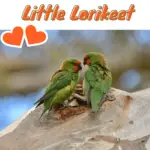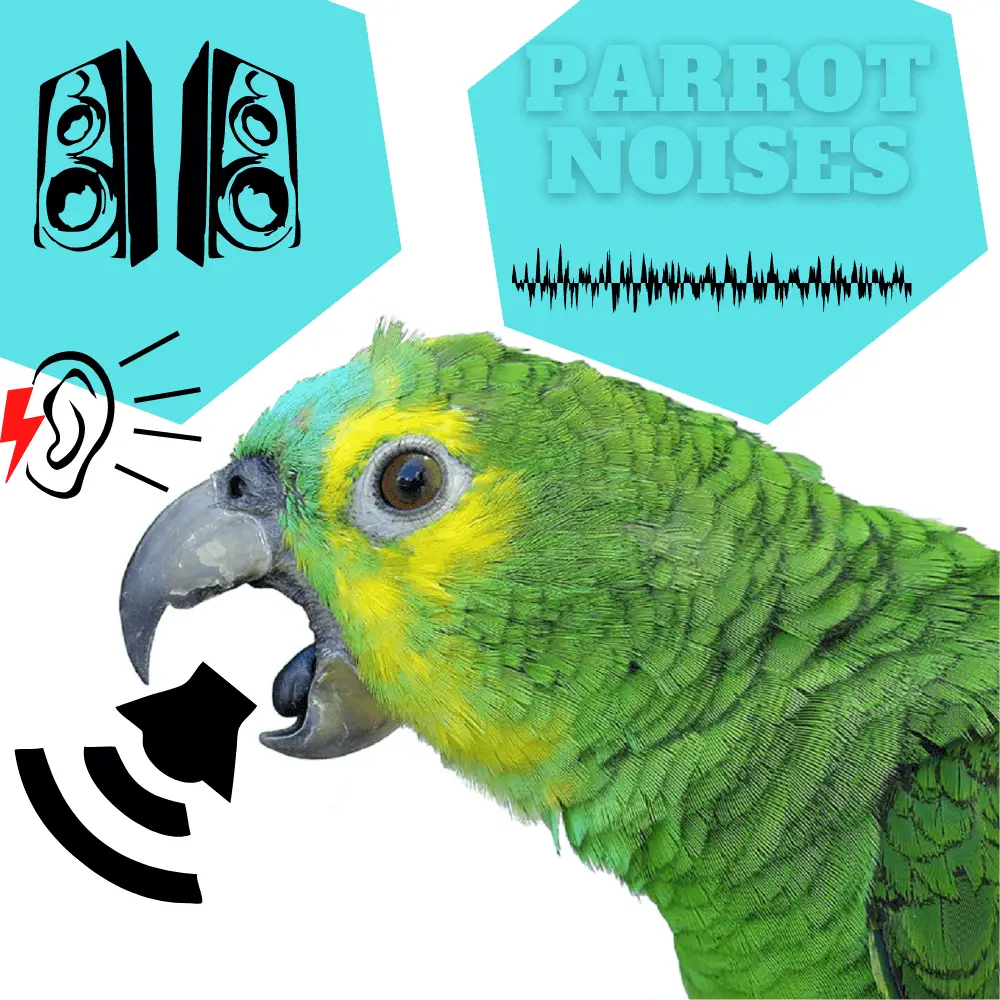
What Do Parrot Sounds Mean?
But not all ways of singing have the same meaning, just like words in our language. Singing, whistling, and talking is often synonymous with joie de vivre.
Some parrots like to have an audience to do so, to the point of intensifying the flow and variety of their vocal demonstrations in society, while others wall themselves in silence at the first foray into their environment.
Chatter can perform different functions. It can be of low intensity or very strong. A gentle babbling can be synonymous with joy or learning words by the animal.
But at high intensity, it can mean “pay attention to me, I’m here!” This also happens in nature, at the beginning and end of the day, to communicate with the members of the colony.
Parrot Sounds And Noises, Parrots also purr. True, it does not resemble the purr of cats, but more like a faint-blown rumbling. Unlike that emitted by the latter, it can be interpreted as a sign of satisfaction or boredom, depending on the context.
The clicks, emitted by slamming the tongue against the beak, express the quest for a caress or the will to be on their human, but it can also simply be a game.
Finally, our birds can produce grunts. Just like in dogs, their connotation is aggressive. When this happens, it is, therefore, necessary to avoid physical contact, the risk of the defensive bite being important, and to look for what could explain this behavior in their environment.
Beyond what we hear, the vocalizations of our parrots can therefore vary and therefore have a different meaning depending on the context, but also the individual who produces them.
If for the timidest of them, it is even more important to pay attention to it, it brings nuances in the subject, regardless of the bird concerned.
Parrot Sounds And Noises
Parrot voice

Parrot noises
Bird educator and behaviorist
Parrot Sounds And Noises, parrots this great talkers!!! He vocalizes from morning to night while keeping an ear always attentive to the slightest sound that could enrich his vocabulary.
Easy to teach words to a parrot… that’s what any good pirate movie wants us to believe! But if you want to know the or rather the real methods take the time to read what will follow.
First of all, keep in mind that “the parrot only ever speaks his mother tongue” (Georg Christoph Lichtenberg), which will make your parrot a reflection of your teaching.
He will not discern the different languages, so you can make him an outstanding polyglot! However, your parrot will not always master the value of the spoken word as well as its scope; So avoid teaching him words with an inglorious meaning…
The basis of the methods that I will share with you is based on behaviorist theory (in other words, which is based on observable behavior) and stems from a process of conditioning. As with many learnings, interactions are essential. You must therefore form a real knowledge transmission buddy with your feathered companion.
Parrot making noises
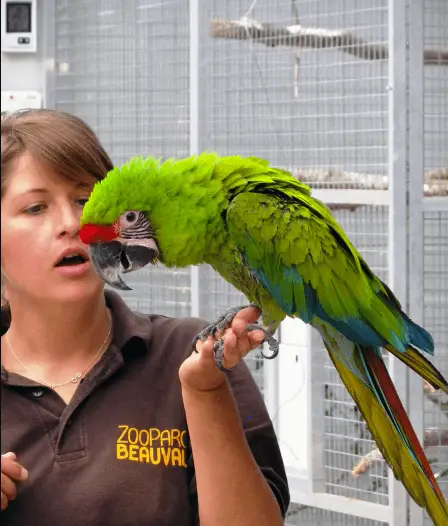
Parrot noisesparrot who talks
Parrot who talks
SOURCE:Insider
Parrot sounds
Parrot Sounds And Noises, Small anatomical and physiological reminders regard to the production of sounds in birds.
The syrinx is the vocal organ specific to birds, it is located at the level of the bifurcation of the trachea and the 2nd or 3rd thoracic vertebra. It is surrounded by airbags.
The cartilaginous structure vibrates a membrane in front of two pavilions serving as a sounding board. The syrinx, therefore, has a preponderant role in the production of sounds in all birds. The movements of the tongue allow modulations of frequency and amplitude of the sounds emitted.
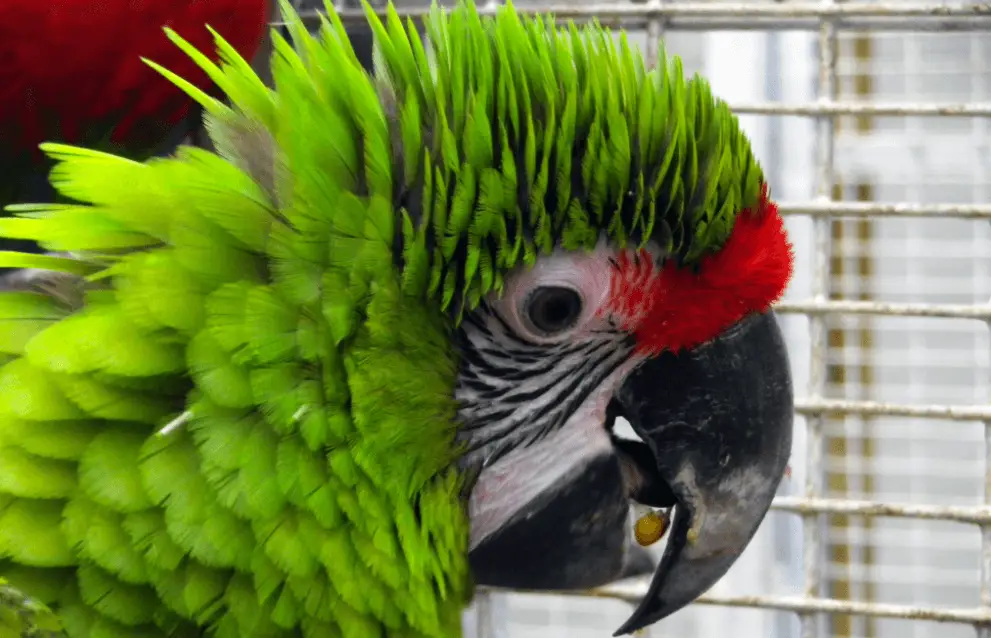 Parrot noises
Parrot noises
Bird species capable of vocal learning have 7 brain nuclei involved in motor skills (syrinx and tongue) and acoustic information processing.
8 Parrot Sounds Meaning | INDIAN RINGNECK ?
SOURCE:Džedemina
Parrot vocal learning
Many species of birds have imitation and vocal learning abilities and are thus close to humans in their ability to learn a language.
Communication can be defined as the transmission of a signal between a transmitter and a receiver. For the parrot, vocalization is one of the basic communication methods of the species. Parrots are not songbirds but males and females vocalize all year round.
Like humans, young parrots go through a vocal learning phase called “babbling” during which young people produce many vocalizations. And, as in many other areas, parrots can learn all their lives.
Parrot making noises

Parrot noises
The parrot communicates to exchange information between individuals, to gather or to learn (about the other partner, his emotional state, his motivation, his identity, his environment …).
Communication is a sign of good individual health and good integration within the group in which he lives. If your parrot vocalizes assiduously every day, take it as a compliment; he tells you that everything is fine in his life and that he feels good in his adoptive family.
Communication is called referential when it categorizes a specific case. The best-known example of referential communication encountered in the natural environment is the cry of alarm.
In some species, the communication is very advanced since the vocal repertoire varies according to the threat (the best-known example is the alarm call varying according to the threat in some corvids).
ALEX THE GREAT
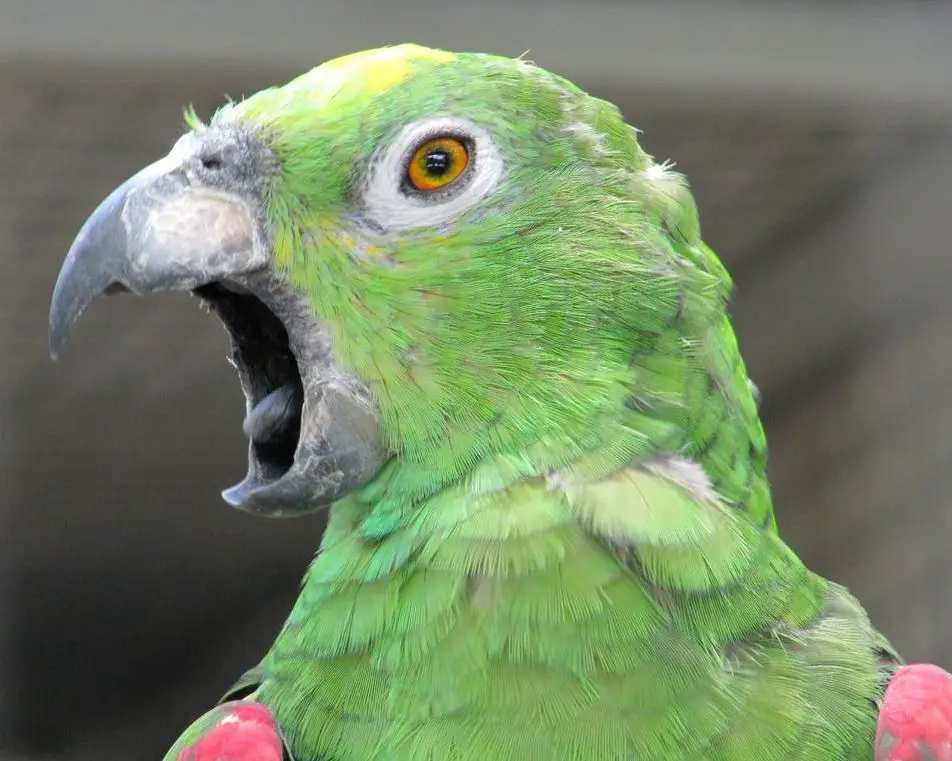
Parrot noises
Alex Parrot Sounds And Noises Although parrots have long been considered less intelligent than mammals, and especially primates, it turns out that many species of birds including the family corvids and psittacines have developed cognitive abilities, even similar to those found in primates including humans.
Among the birds, corvids and psittacines are excellent students. Here crow magpie (Corvus albus).
You’ve probably already heard of the famous parrot Alex (for Avian Learning EXperiment), who sadly passed away in September 2007, and leaves behind a series of results demonstrating that parrots are not just imitators. This work was carried out in the laboratory by Irene Pepperberg’s team on greys from Gabon.
Alex and Irene Pepperberg during a working session.
Alex knew how to referentially imitate many human words. He knew how to name more than a hundred objects and give different characteristics according to the question he was asked.
This went even further since he knew how to name the commonalities and differences between objects, for example, shape, color, texture…
He also had the concept of absence. Alex knew how to count to 6 and also knew how to compare objects by saying that he was “bigger than”. Alex was, therefore, able to describe elements and events of his environment by using a communication system, namely words, and therefore to communicate functionally.
THE STAGES OF LEARNING
As with our children, parrots go through different stages when learning a new word.
First of all, there is a “listening” phase during which Coco hears the sounds produced, just as we do when learning a new language.
Then comes the “approximate” stage during which the bird practices producing the sound heard during the previous phase. Very often this stage goes unnoticed because the parrot trains in the absence of any human presence.
In most situations, imitation is not perfect the first time but requires several ripening sessions. This stage can last more or less long depending on the individual.
Then the word is pronounced clearly and takes an important part in the repertoire of the animal, it is the phase of “appropriation”.
Finally arrived at the last stage called “normalization”, the “fashion” effect of the new word begins to decrease and gives way to other types of vocalization. However, this phase may not exist if the bird appreciates, or finds interest in pronouncing the word.
How to Understand Your PARROT
SOURCE:MARLENE MC’COHEN
HOW TO MAKE YOUR PARROT A BIG TALKER?
We saw with Alex that parrots are capable of vocal learning that goes so far as to describe objects using human words. I hear you think!!!.. Of course… You know that it is with pleasure that I will explain to you the methods that you will be able to apply with Coco:
o The “model /rival” method
o The “intuitive” method
o The “repetition / association” method
o The “dissemination” method
Whatever the method envisaged, each one uses the name and form for the pronunciation. In addition, the presence of a real model is essential.
It is important to show your parrot student his mistakes in order to help him move forward positively in his learning
The “model /rival” method
The “model/rival” method could be defined as a role-playing game between two “teachers” and a “student” who is your parrot. Note that the respective roles of teachers are switched regularly. Teachers exchange around a specific object by designating it with “what is it?”.
The “teacher” answering the question then represents a model for the parrot. The parrot must be solicited by the teacher and can also manifest itself spontaneously.
The purpose of this method is to achieve that the “model” thus becomes a “rival” with regard to the parrot. Yes! Given the fact that your parrot also seeks to obtain the coveted object and attract the attention of the person who interrogates it, one of the “teachers” then becomes his rival.
In this role play, eye contact between the teacher, the interviewees, and the object in question is essential.
The correct pronunciation is rewarded with congratulations and by the object itself. Intentional pronunciation errors must be made because Coco also observes the possibilities of correcting the pronunciation of the item name.
The “intuitive” method
The “intuitive” method is an interaction between the “human teacher” and the parrot. Its simple principle is to designate objects by name.
During a lesson, it is necessary to alternate phases where the animal watches the human interaction with the object, where the bird interacts with the object, and where the human looks at the bird.
At first, the human pronounces unique words and then integrates short sentences including 2 to 4 words maximum (“a grape”, “you want the toy”, “you eat a banana” …).
You must communicate with your parrot through visual contacts, voice exchanges, and demonstrations of the possible use of the object (use the toy, shell a seed, …).
Let the parrot have free access to the object. The human intervenes by giving it to him or taking it back by making sure to name the object.
If we compare this method to that of the “model/rival”, we can attribute to it a more functional character since the parrot interacts with the object several times. However, a single human involved in the course of the session can weaken interactions.
The “repetition / association” method
The “repetition/association” method consists of 2 phases separated in time. Let’s see together the steps to follow.
During the first session, repeat to your parrot 2 or 3 words without the latter seeing the corresponding object (we will name these words “word-label”, and of course, you will have selected them beforehand).
Make sure Coco pays all her attention when the pronunciation of words (direct eye contact, changes in rhythm and intonation, physical movements…).
Now that your parrot has learned and is imitating your label words, let’s move on to the second step! This is the phase of the association during which the animal must associate its word label with the corresponding object.
It is therefore during this phase that the referential and functional characteristics of the interactions are restored. In a word, every time the animal produces the word label you reward it by offering it the item and congratulating it.
This method is the most reinforcing because of its many interactions: we congratulate the bird, we give the object by repeating the word label, etc.
Knowing well the behavior of psittacines, I think it is partly for this reason that the scientific results of this method have led to excellent successes (the “repetition/association” method has borne fruit from the first 20 sessions and has given the best scientifically validated results).
The “dissemination” method
The “diffusion” method is the most technological of all! As with the “repetition/association” method, there are two separate steps in time.
The first phase puts you alone to work, yes! This is what you need to set up: as with the previous method, select two or three label words and then save them with or without intonation as an audio file. Then, in your absence only, broadcast this recording to your parrot.
The second part of the method is identical to that used in the “repetition/association” method: each time the parrot produces the word label you reward it by congratulating it and offering it the object in question.
This method is perhaps the one that offers the least success. What for? Maybe because the parrot is a very sociable living being and the virtual does not captivate him very much if you know what I mean ….!
THE WINNERS ARE …
Some species have more facilities and enthusiasm to learn the human language.
Let’s start with the species least attracted to voice learning. As beautiful as it is the Sun Conure (Aratinga solstitialis) is not a great talker, as are its other cousin’s conures of the species aratinga (conure Nanday (Aratinga nenday), conure Jendaya (Aratinga jandaya) …).
Alisterus (medium-sized parrots predominantly red and green characterized by a long tail, royal parakeet for example) and black cockatoos (Banks’ cockatoos (Calyptorhynchus banksii), Black microglossus (Probosciger aterrrimus) are also not very talkative.
Amy and Groucho, a real star! This golden-naped Amazon (Amazona auropalliata), star of the Disney Animal Kingdom show, is able to pronounce and understand the meaning of many words, she is best known for her talent as a singer (she knows 7 different songs).
Others are much more receptive to vocal learning and the assimilation of human vocabulary. The most in-demand are surely the African Grey (Psittacus erithacus), the white and pink cockatoos but also the Amazons.
Loris can demonstrate beautiful faculties of vocal imitations. Small cockatiel parakeets (Nymphicus hollandicus) or wavy parakeets (Melopsittacus undulatus) are often the subjects of amateur videos easily demonstrating their interest in chatting.
Again, while species can influence vocal abilities, motivation and vocal learning abilities also vary from individual to individual.
Which parrot talks the most
SOURCE: Alen AxP
CONCLUSION
Parrot making noises, Vocal learning in parrots is an initiation and fundamental experience in his life. All species of psittacines are capable of vocalizations with human sounds. Some species such as Gabon greys, amazons, or cockatoos excel, particularly in this area.
Whatever the method applied, keep in mind that:
-the sessions must be short (at most fifteen minutes) but reproduced regularly
– always remember to reward Coco when her work is successful, her involvement will only be better!
– positive reinforcement will be your best ally
– the importance of interactions is paramount to successful learning
– your sincere involvement is fundamental
– each parrot has its own personality and its own pace of learning, so you will have to find the method or methods most appropriate to its character
– be patient! And keep your mind playful, you’re not in school!


